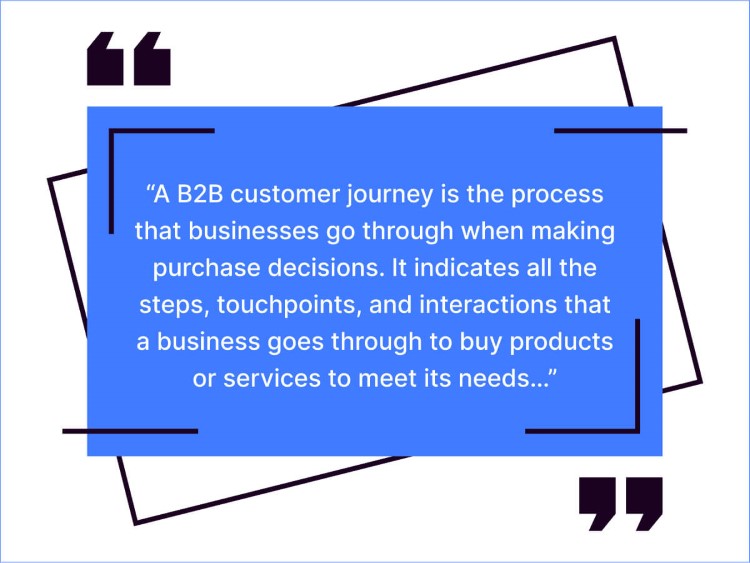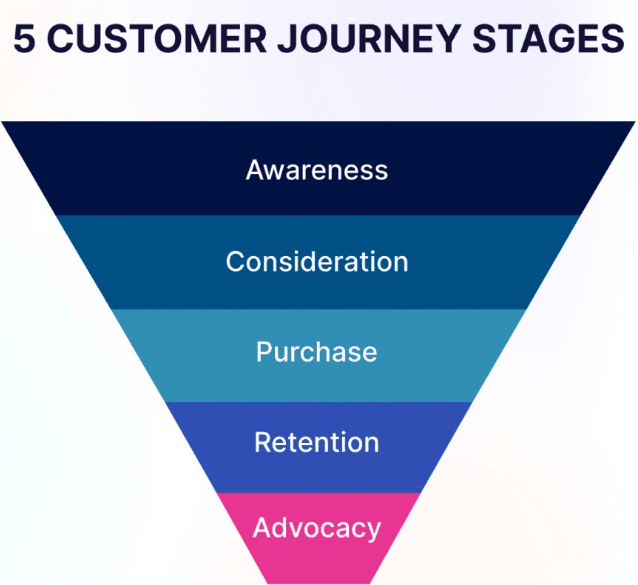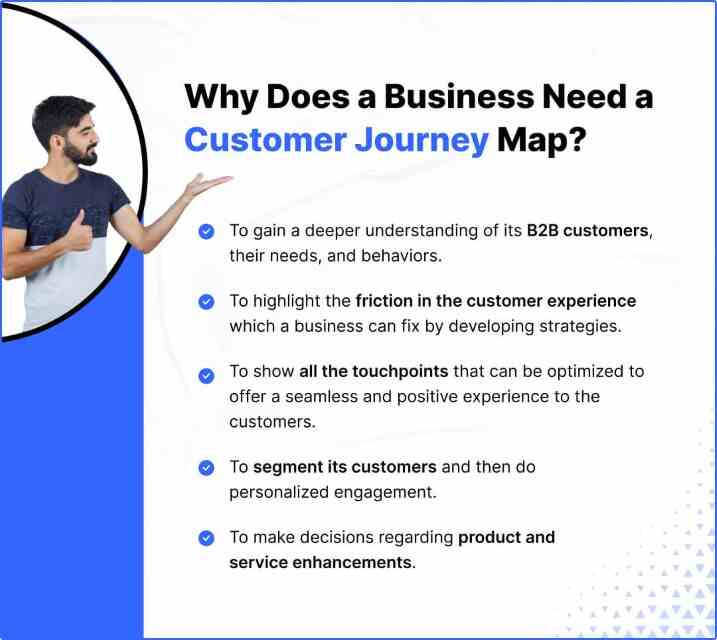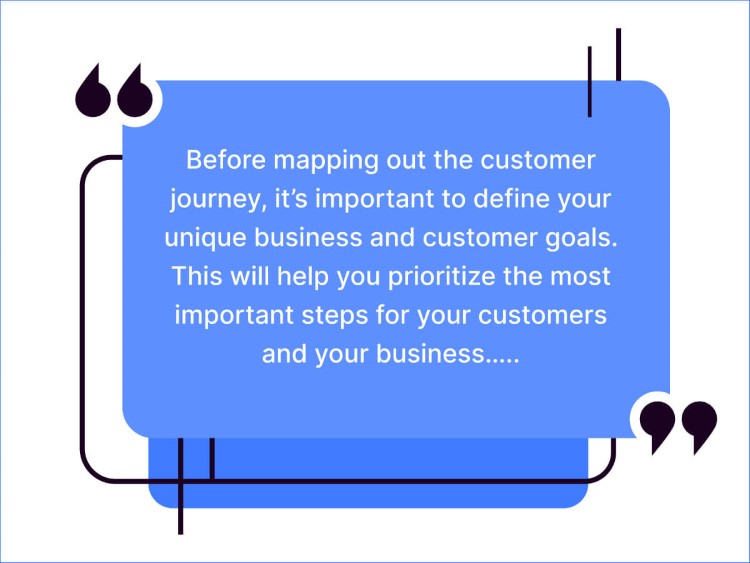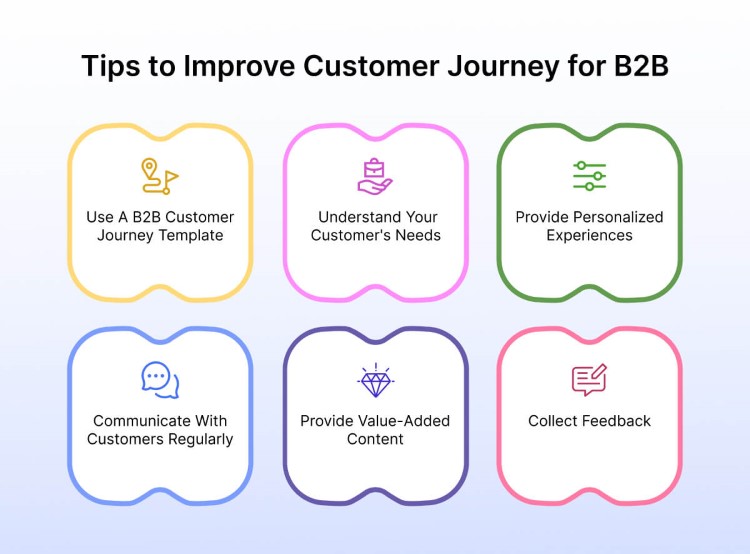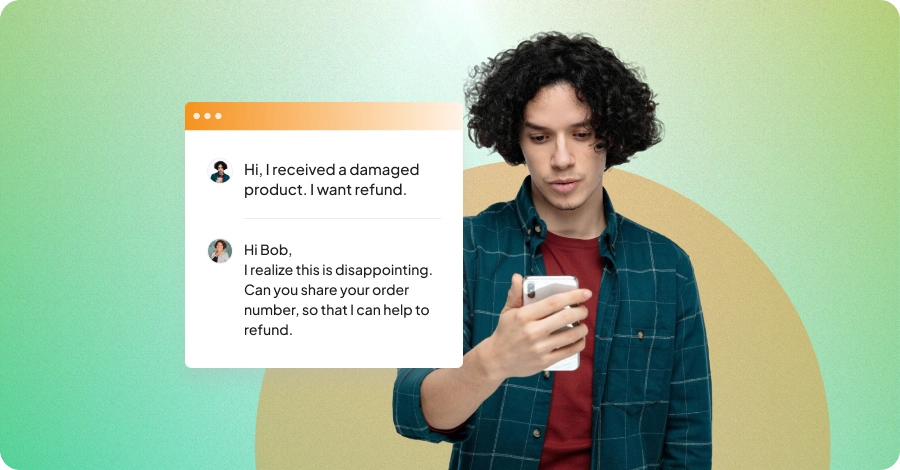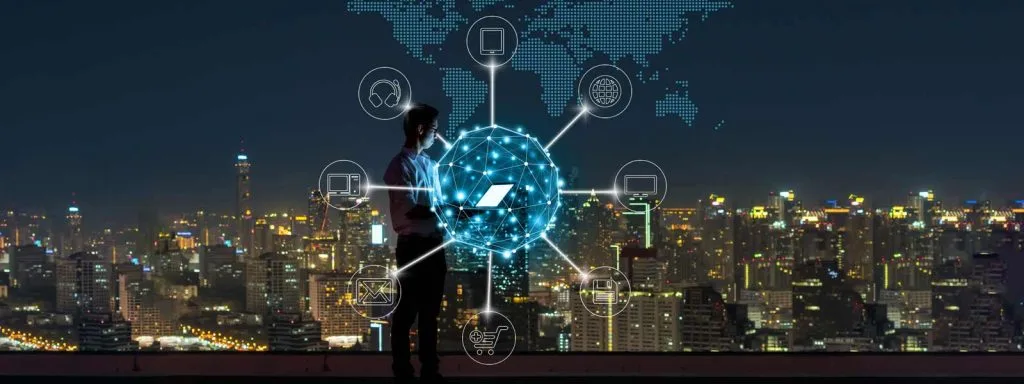B2B Customer Journey Map with Stages & Examples
- October 19, 2023
- 20 mins read
- Listen
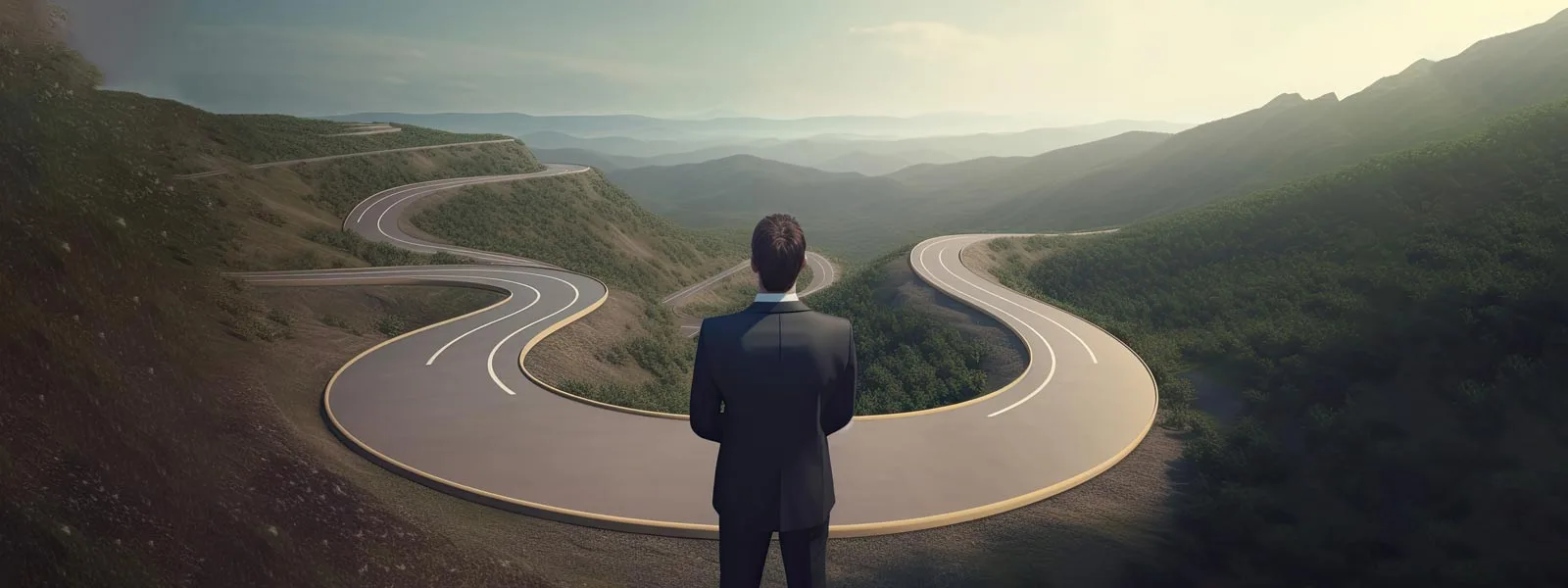
The B2B landscape is very competitive these days. It’s also full of a host of touchpoints that affect customer experience. With buyers becoming more informed than ever, businesses have no choice but to understand the customer journey better to align their efforts with customer needs and expectations.
Similarly, a business also needs to understand all the complexity involved with the B2B customer journey as it helps in planning their marketing and customer service strategies. Unless this journey is understood, a business-to-business company will not be able to engage and convert potential customers effectively.
Throughout the B2B customer journey, your business needs to provide value-added content and offer exceptional customer support to build long-term relations. It’s equally important to tailor the approach to the specific needs of the customer at each stage of the journey to drive sales and conversion.
In this blog, we will explore the B2B customer journey in detail, understand the various stages involved therein, and also look at the journey map.
But first, let’s get started with understanding what the B2B customer journey is…
What is a B2B Customer Journey?
A B2B customer journey is the process that businesses go through when making purchase decisions. It indicates all the steps, touchpoints, and interactions that a business goes through to buy products or services to meet its needs.
This journey includes every stage a customer has with a B2B company, right from the very first encounter to the post-purchase. More so, from the initial recognition of a need to the final purchase decision and beyond, a business-to-business customer journey outlines all the steps that a customer goes through.
For a business, understanding the B2B customer journey is key to effectively engaging and converting potential customers. This understanding is also vital to aligning the sales, marketing, and support strategies with the specific needs of the customers at each stage.
Types of Customer Journey Maps
Customer journey maps are visual representations of a customer’s experience with a brand, product, or service. There are various types of journey maps focusing on different facets of the interactions. Businesses often use these maps to gain a deep understanding of the customer experience.
Here are the different types of customer journey maps –
- Current-state journey map – This map type represents the customer’s current experience with a product or service. It details all the touchpoints and interactions together with highlighting the pain points.
- Future-state journey map – This type of journey map visualizes the ideal customer experience after making improvements to the existing map. Businesses often use future-state maps to set goals and priorities to boost customer experience.
- Persona-based journey map – This type of journey map emphasizes the journey of a specific customer persona. Businesses often use the persona-based map to tailor their strategies to different segments. Such maps are very helpful for understanding each customer segment’s needs and pain points.
- Channel-specific journey map – This type of journey map helps businesses examine the customer journey with a specific channel. Using a channel-specific map, a business can optimize the experience within that channel.
- Cross-channel journey map – This type of map is used to explore the customer experience across multiple channels. Using a cross-channel map, a business can maintain consistency in experience across touchpoints.
The B2B Customer Journey Stages
The B2B customer journey is made up of several stages that a customer goes through in making a purchase decision. These stages are what a business can understand to better engage with their customers. However, these stages can vary depending on the product, service, or industry.
In general, here are the stages involved in a B2B customer journey –
1. Awareness
This stage indicates that the buyer is aware of your product and service, and it also indicates that your marketing effort has played its part in creating that awareness.
2. Consideration
This stage is reached when buyers are already aware of your product and service and they start to weigh their options and do comparisons.
3. Decision
This is the stage where buyers will make decisions on your product and service.
4. Purchase
This is the stage when the purchase happens and your role is to ensure that the process goes smoothly and all customer expectations are met.
5. Loyalty
A customer who has purchased once may return for more if the service and experience were good earlier. It will depend on the effort you take to build loyalty over time and enhance their experience with your brand.
6. Advocacy
Offering great experiences can turn your customers into advocates who will spread positive word-of-mouth about your business.
What is a B2B Customer Journey Map?
A B2B customer journey map is a visual illustration showing all the steps a customer has to take when engaging with your business. It outlines the various stages, interactions, touchpoints, and experiences that a B2B customer takes. This map works as a helpful tool for businesses to understand and improve the customer experience.
Why Does a Business Need a Customer Journey Map?
A B2B customer journey map is important for various reasons, including –
- By creating a customer journey map, your business will gain a deeper understanding of its B2B customers, their needs, and behaviors.
- A customer journey map can highlight the friction in the customer experience which a business can fix by developing strategies.
- A journey map highlights all the touchpoints that can be optimized to offer a seamless and positive experience to the customers.
- A business can leverage the detailed journey map to segment its customers and then do personalized engagement.
- A good understanding of the customer journey is central to decisions regarding product and service enhancements.
B2B Customer Journey Touchpoints
A business must first define and then evaluate all possible touchpoints if it wants to create a coherent customer journey. This will help it understand the touchpoints requiring more focus and the ones promising the maximum chances of success.
Here are the B2B customer journey touchpoints –
Pre-purchase touchpoints
Before making a purchase decision, a customer will often go through many touchpoints. First, he/she will realize a need, and then locate the sources of information to meet the need. So, typical touchpoints for customers before making a purchase may include search engines, blogs, case studies, how-to-videos, forums, and testimonials.
Touchpoints during the purchase
When customers have assessed their needs before purchase, they typically move on to the next stage of making the purchase. The good thing is that customers nowadays have the flexibility to buy products or services through different channels. So, the possible touchpoints for customers during the purchase include the website, brick-and-mortar store, catalog, and phone sales.
Post-sales touchpoints
Purchase is not the end of the customer journey. Businesses must also focus on their customers when the purchase is done. This is where post-sales touchpoints play a key role for the business. Some of the key post-sales touchpoints include customer service or support, newsletters, feedback, and surveys.
The Difference Between B2B Customer Journey Maps and B2C Customer Journey Maps
The way B2B businesses interact with their customer is very different from the way B2C businesses do. This is why B2B customer journey maps look different from B2C customer journey maps.
Here are some of the key differences between both types of journey maps –
|
B2B |
B2C |
|
Multiple people are involved in the purchase decisions |
One or two people are involved in the purchase decisions |
|
Not all decision-makers may be visible to the sales team |
All decision-makers are visible to the sales team. |
|
The purchase and implementation teams may be different |
Purchase and implementation teams are mostly the same group of people |
|
Order value is larger in size but the order frequency is small |
The order value is smaller in size but the order frequency is big |
|
The buyer journey is complex and involves multiple stages |
The buyer journey is simple |
|
Each customer journey will have unique needs and requirement |
Each individual journey is less significant |
|
The customer journey process may require adjustments from time to time |
The customer journey process stays the same |
Steps to Create a B2B Customer Journey Map
Creating a customer journey map is essential for your business to understand all the places stages and interactions that a potential customer goes through in contacting your business. This knowledge can better prepare you to handle customer issues and improve your sales, marketing, and sales efforts, leading to more sales and improved conversions.
Here are the key steps to create a customer journey map for your B2B business –
1 – Set your unique business goals
Before mapping out the customer journey, it’s important to define your unique business and customer goals. This will help you prioritize the most important steps for your customers and your business.
When it comes to defining unique business goals, the key is to ask yourself what you want your customers to achieve. Does your business sell a one-off priced item or are you relying on repeat purchases? This question is important as as customer journey map may look different in both situations.
Obviously, your unique goals will set your business objectives and that’s why no two businesses’ map looks exactly the same. Some companies may be interested in generating more website conversions while others may focus on increasing customer retention.
So, you should know your goals before mapping out your B2B customer journey. It will help you focus more on the key steps for customers.
2. Identify your customer segments
The B2B purchase process is complex. The complexity arises out of the fact that the end users and people making the purchase decisions may not necessarily be the same person. In fact, most of the time, multiple people have a say in a B2B purchase decision, so it’s important to consider all the stakeholders together.
You should understand everyone involved in the purchase process to map out an accurate customer journey. This step is vital for considering how user personas may vary depending on the type and size of a company.
With big businesses, you will get different user profiles and needs and each one may have their unique user journey. All this insight can help prepare you to ensure better products and experiences for your relevant customer segments.
3. Define your buyer personas
Now that you have identified your customer segments, the next step is to define a buyer persona representing each of your customer segments. These personas are semi-fictional representations of your ideal customers based on real data about them and based on market research.
Using these buyer personas, your business can better identify and target the audience and tailor marketing efforts specific to the customer journey. More so, they can help your business reach more potential customers as you leverage the real data about your existing customers.
You will need a variety of customer data when building out a buyer persona, including –
- Demographic data such as age, location, gender, and income
- Information related to the job title, industry, and the company they are part of
- Data related to hobbies and interests
- Insights related to the buying behavior and buying patterns of your audience
- Knowledge about the challenges and pain points they have
- Their goals and objectives
4. List all possible customer journey stages and touchpoints
To prepare a journey map, you will need to define and list all the possible stages of the customer journey. These stages may vary from industry to industry but typically they include, Awareness, Consideration. Decision, Purchase, Loyalty, and Advocacy. Once you have defined all the stages in your customer’s B2B journey, the next step is to identify all the touchpoints where you expect customers to interact with your company. They could be anything, from your social media posts to homepage CTAs, etc.
The purpose of clearly defining the touchpoints is to help customers move smoothly through the journey and show them the next step. The more information you provide them at each touchpoint, the better the decision they can make. When you identify the journey stages and touchpoints, you can improve UX and convert customers into brand advocates.
5. Analyze customer pain points
When creating a customer journey map, you should always consider any bottlenecks that may cause difficulties for your customers. You should identify any pain points as you map out the journey. Make sure you are aware of any areas that may disrupt the flow of the customer journey and cause issues for the customer.
The key thing in analyzing customer pain points is to check whether your touchpoints are aligned and whether all channels are working together to ensure a seamless journey for your customers. To minimize pain points, consider adopting an omnichannel strategy so that all your channels work together and you deliver the kind of smooth experiences desired by customers.
6. Develop an action plan
Now that you have put together all elements of the customer journey, it’s time to devise an action plan for building out the map. The key is to make sure all touchpoints are covered and you have made the improvements.
When developing an action plan, ensure that –
- Create a stakeholder for each touchpoint
- Add any touchpoints if needed so that all customers are attended to
- Add live chat or chatbot or video chat option to improve customer experience
- Build more options for offering personalized customer experiences
- Consider any issue mentioned by customers during surveys or research
- Fix those issues one by one
7. Monitor and improve
Customer journey mapping is an ongoing process. So, your focus should be on monitoring and improving this journey on a continuous basis. The key is to keep collecting feedback and data on the customer journey and see if any changes or improvements are needed.
Whether new or existing customers, you need to gather data and track the analytics to see any bottlenecks and issues along the customer journey. Similarly, you’d better service if you considered measuring and tracking a few metrics such as NPS, CSAT, CLV, and retention rate.
There are many popular customer journey mapping tools that you can use and map and monitor the journey easily. It’s essential to keep an eye on the customer journey and get new data so that you can spot the issues and adjust to the changes.
Tips to Improve Customer Journey for B2B
Customers always want a smooth journey when they interact with a brand. When the journey is smooth and hassle-free, it adds to their overall experience with the brand. However, not all businesses are able to provide that kind of experience. Here are some tips to improve the customer journey for B2B –
Use a B2B customer journey template
A lot of businesses now build customer journey maps to better engage with their audience and drive conversion rates. Naturally, you’d want to follow in their footstep and devise the same strategies for serving and converting customers. You can use B2B customer journey map templates of different industries such as SaaS and e-commerce etc. and get a better idea of how to improve yours.
Understand your customer’s needs
A detailed customer journey map is possible only when you understand your customer’s needs, pain points, goals, and challenges. Based on this understanding, you can drive every aspect of your strategy related to the customer journey. This will also help you develop detailed buyer personas for your B2B customers. Plus, 86% of customers will pay more for a better experience.
Provide personalized experiences
Customers love personalized experiences as this enhances their overall experience with your brand. You should therefore strive to tailor all your sales, marketing, and support efforts to the specific needs of the buyer in different stages of the journey.
Communicate with Customers Regularly
The more you communicate with your B2B customers, the better you can understand them and engage them. In addition, it will also help your customers stay informed and make good purchase decisions. The goal should be to make available various channels of communication to customers and send them regular updates to them.
Provide value-added content
The purpose of content is to educate, entertain, and enlighten customers. You should have a robust content strategy so that you can offer a variety of content types specific to the customer journey stages. More so, the content you provide will douse their doubts and solve their problems.
Collect feedback
Customer feedback is important if you want to offer them great service and improve your products and services. Good companies make it a point to regularly collect feedback from their B2B customers and act on it. Together with collecting feedback, it’s also important to implement the suggestions and add to the overall experience of your customers.
Optimizing the B2B Customer Journey: Best Practices
Enhancing customer satisfaction is the main purpose of optimizing the B2B customer journey. Businesses often optimize the customer journey to gain customer loyalty and achieve overall success. For that reason, there are certain best practices to follow in forging strong relationships with customers and increasing satisfaction.
Let’s look at the best practices in optimizing the B2B customer journey –
- Adopt a customer-centric mindset and put the customer at the core of your business strategy.
- Align all your business processes and procedures to deliver value to customers at every possible touchpoint.
- Gain a better understanding of your target audience by creating detailed customer personas.
- Create elaborate journey maps and consider all touchpoints to get a holistic view of the customer experience with your brand.
- Foster cross-functional collaboration so that everyone across departments is aligned to the cause of ensuring a consistent customer experience.
- Collect real-time data and leverage analytics to gain insights into customer preferences and behavior, and use the information to optimize the customer journey.
- Provide proactive support where you anticipate potential customer issues and fix them before they become big challenges for the business.
- Use content marketing strategically to enhance customers’ understanding of your products or services.
- Focus on multi-channel engagement and consider the fact that B2B customers can interact and engage through various channels.
- Measure customer satisfaction to know how happy they are at each stage of their journey.
Technology to Improve the B2B Customer Journey
Technology has a big role to play in creating a seamless and personalized customer journey. It helps businesses a lot in streamlining processes and improving the overall customer satisfaction. All this can have a positive impact on the B2B customer journey.
Let’s look at the role of technology in improving the B2B customer journey –
Artificial Intelligence (AI) and Machine Learning (ML) – Many businesses these days rely on AI-powered chatbots and virtual assistants to enhance the customer experience. They also use AI-driven recommendation engines to serve customers better at every stage of the journey. This shows how AI and ML technologies can play a big role in improving the overall B2B customer journey.
Customer Relationship Management (CRM) Systems – The role of CRM systems is big in storing valuable customer data and tracking interactions. They are used to gain insights into customer engagement by analyzing interactions throughout the lifecycle. This shows the role of CRM systems in improving the B2B customer journey.
Marketing Automation Tools – More marketers now use automation tools to engage customers better and gain a comprehensive insight into their behavior and preferences. These tools not only help in automating a variety of tasks across marketing but can also contribute to nurturing leads. This shows how they can act as a key technology in improving the B2B customer journey.
Customer Feedback and Survey Platforms – Feedback is vital in understanding customer satisfaction levels and identifying pain points. Many businesses leverage survey and feedback platforms to collect valuable insights from customers and then make needful adjustments to their engagement strategy. This shows their huge value as a technology in improving the B2B customer experience.
Customer support and service solutions – Businesses are using real-time chat and support to respond to customer queries promptly and reduce wait time. There are helpdesk software and ticketing systems that are used to manage customer requests and improve the efficiency of support. This shows how customer service tools and solutions can act as a key technology for improving the B2B customer journey.
B2B Customer Journey Example
B2B customer journeys are unique to the specific needs of the customer. They also vary as per the industry, product, or service type. For a business, it’s therefore important to understand those journeys and stages to better meet the needs of their customers. Here are some B2B customer journey examples from across industries –
Software as a Service (SaaS) Company
For a SaaS company, a B2B customer journey starts when the clients become aware of the product through web research, social media posts, or some industry events. The customer in this industry often analyzes and evaluates the product through a demo or sometimes reads case studies as well. The customer may also reach out to the sales team with questions and based on the interactions, may decide to buy, negotiate terms, and complete the purchase. After that, the onboarding and support stages happen.
Commercial Real Estate
A B2B customer needs office space and comes to know of a broker through online searches and referrals. The client will contact the broker, share their requirements, and then get properties to review. Based on the review, a property is selected, its lease terms are negotiated and agreements are signed. Now when the purchase is done, the new space is occupied with the broker assisting with set up and maintaining contact with the client for future lease renewals and other needs.
IT Service Provider
An IT service company feels the need for improvements to its tech and service infrastructure. It then researches IT service providers through online searches and requests quotes. Based on the extensive analysis and assessment, the customer selects an IT service provider, finalizes contracts, and starts the project. The provider then deploys solutions and offers training to the workforce. Even after the project is finished, the provider may stay in touch with the B2B customer offering support, maintenance, and monitoring.
Final Thought
B2B customers are quite evolved now and they expect great experiences when they connect with a business. Their journey is also very complex and involves multiple stakeholders. So, you will need a well-designed journey map to remove any bottlenecks from their journey and add value to the steps they take in purchasing with you.
With REVE Chat, you can sign up and check a variety of engagement tools that will help you connect well with your audience.

